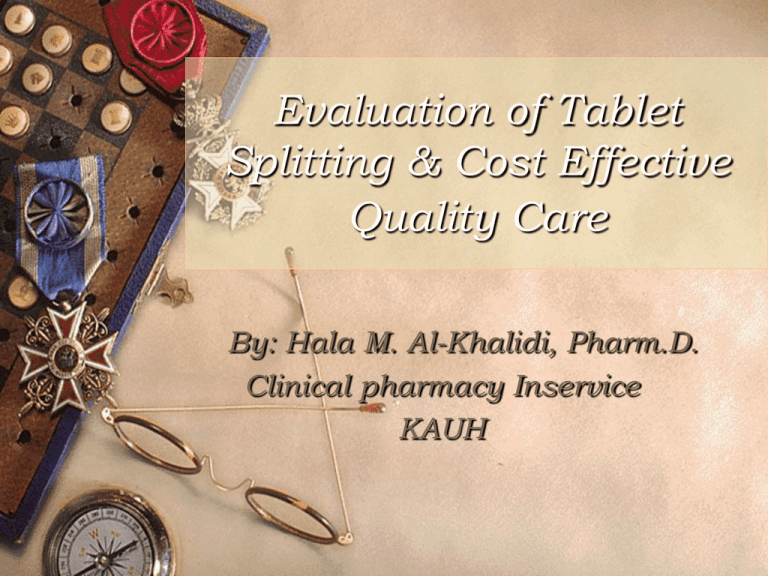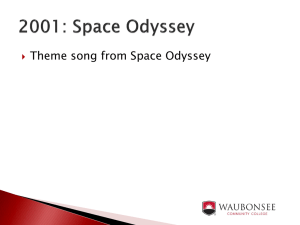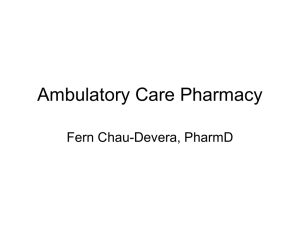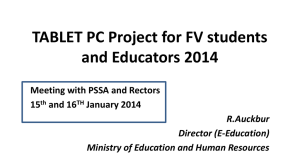Arguments Against Tablet
advertisement

Evaluation of Tablet Splitting & Cost Effective Quality Care By: Hala M. Al-Khalidi, Pharm.D. Clinical pharmacy Inservice KAUH Introduction Alert health care professionals about dosage forms that should not be crushed or split which may result in alteration in its therapeutic effect. An overall assessment of tablet-splitting. Arguments against splitting tablets. Accuracy with narrow therapeutic index, & smaller tablets. Consult with the your Clinical Pharmacist on Drug Formulations Q/A’s….. Introduction Limitations that may lead to poor patient compliance. Older adults with cognitive impairment, may forget to cut the tablet in half, and result in toxicity from higher doses. Studies for stability of medications are generally dun with intact tablets. Types of cutters & medication boxes. Dosage forms that should not be crushed or split Crushing or splitting a solid medication is critical which may lead to loss of efficacy or pharmacokinetics of the formulation, e.g. sublingual or buccal, enteric-coated, and extended-release tablets or capsules. Abbreviations are affixed to brand names and tablets, clue that crushing/splliting may effect formulation. Some medications can be irritating to oral mucosa and/or UGIT, bitter, stain oral mucosa & teeth. Dosage forms that should not be crushed or split Enteric-coated – Formulated to pass through the stomach intact with drug being released absorbed in the intestine to: a. prevent drug dissolution by stomach acids. b. prevent stomach irritation. C.delay onset of action. Dosage forms that should not be crushed or split Extended-release - formulated to release drugs over an extended period which may include: A. multiple-layered tablets which releases the drug one layer at a time. B. mixed released pellets that dissolve at different time intervals. C. special matrix formulations that are them selves inert, but slowly release drug from the matrix. Dosage Forms that should not be Crushed or Split Sublingual - formulated to dissolve quickly in oral mucosa giving rapid absorption, by abundant blood supply of the mouth. Miscellaneous - oral mucosa irritation. - bitter taste - dyes staining teeth and oral mucosa - handling carcinogenic drugs. Common Abbreviations for Extended-Release products Abbreviation CR CRT LA SR TR TD SA XL XR Interpetation Controlled release Controlled released tablet Long acting Sustained release Time released Time delay Sustained action Extended release Extended release Dosage Forms that should not be Crushed or Split Carcinogenic medications require caution/ limited handling these cytotoxic drugs, exposing handlers to potential health risks teratogenic/carcinogenic effects, will not ulter dosage form or delivery. Capsule contents which can not be crushed may added to soft food as applesauce or pudding which will allow proper drug administration. NG tube contents of capsule may be washed down Dosage Forms that Should not be Crushed or Split Some patients may crush tablets and separate powder evenly, but unless the patient has sensitive scale for proper weight measurement of the crushed tablet, uncertainties of proper dosage as tablet splitting can occur. Capsules should not be opened or split unless directed by physician or pharmacist Professional Practice Advisory on Tablet Splitting Tablet splitting has been accepted to obtain a prescribed dose of a medication when it is not manufactured. Particularly useful for pediatrics and geriatrics. The need for gradual increase or decrease of the dose for effective treatment. Medications of multiple dose strengths are priced the same, when tablet splitting can be means of cost effect treatment (price can be cut in half). Selection Criteria Safety & Accuracy is a concern of managed health care system to minimize the chance for errors & ADR these precautions should include the following: Consistent splitting tablet (cutter/finger). A score across the tablet. Clinical data demonstrating the bioequivalence of the split tablet or meet weight variation specification. Selection Criteria The health system’s pharmacy and therapeutics committee should approve the selection criteria Physicians should report any problems with tablet splitting. Patient specific appropriate for tablet splitting. Exception to tablet splitting with justification. Tablets that Should not be Split Tablets that are not scored. Size, thickness, & design. Special coating to protect form moisture. Inconsistent splitting into equal parts. Why Tablet Splitting Became an Issue? Cutting prescription cost by splitting a tablet. Saving money → Maintaining excellent care → Increase quality of life (meeting professional and agency guidelines). Dosage accuracy of a whole vs. cut tablet. United state pharmacopoeia required formulations not vary by >10%. Arguments against tabletsplitting Patients can not split tablets accurately, a study supporting this argument involved: - healthy volunteers. - HCTZ tablet split. - 12% of the split tablet deviated from ideal weight by 20%. - a tablet splitter was not studied. - another report larger tablets were accurately split, however accuracy was diminished with smaller tablets. Arguments Against TabletSplitting Another research group - Cut tablets in half by hand. - Oval tablets with deep score on both sides were easy to cut. - The two pieces were rarely > 10% in difference by weight. - round tablets with a score on one side broke unevenly & part of the tablet was often lost as fragment or powder. Arguments against tabletsplitting - The two halves of a small (7mm) tablet often varied by > 20%. (which is >10% the united state pharmacopoeia requirement). McDevitt et al evaluated patients with no experience of tablet splitting, split tablets by hand or cutter if necessary. - HydroDIURIL 25mg (HCTZ), round scored tablets to cut. Arguments against tabletsplitting - About 40% of tablet pieces differed from there Ideal weight by >10% and, over 12% of tablets were more then 20% weather cut by hand or tablet cutter. Another research group evaluated a pill splitter (LGS health products), found that it works best with large, oblong pills then flat sides, rounded or pointed ends were difficult to position in cutter, also noticed difficulty to cut small pills in half. Arguments Against TabletSplitting Conclusion of studies: - because of variability in dosing with tablet splitting, it may be wise to consider this practice only with larger tablets that have deep score lines. - when accuracy is crucial tablet splitting should be avoided. - EC tablets or any coated tablet are not be split. Arguments against tabletsplitting Contact the manufacture before recommending tablet splitting, medication formulation may be compromised, or there may maybe non-apparent reasons. Weight variability. Lack dose uniformity. Scored-a clearly defined groove in the center of the tablet the the easiest to split. Use caution with small flat tablets Limitations That May Lead to Poor Patient Compliance Understanding how to take medications properly, in addition patient should be welling and able to split tablets and agree to fallow through. Almost 50% of adults are >65 yo, which may show the following: - lack in manual dexterity - Arthritis - visual impairment Arguments Against TabletSplitting - Parkinson’s disease (tremors). - Cognitive impairment that limits there ability to understand or remember instructions for tablet splitting. - Any functional impairment. The purpose here is to high light this practice negative impact on older people who may be subject to this matter. Arguments Against TabletSplitting Older adults often need lower doses then younger adults, as a result, these patients may forget to cut tablets and may take full pill, and experience toxicity from receiving a higher dose of medication. Stability of Medications Studies on stability of medications are generally dun on intact tablets. Cutting tablets in advance & exposure of tablet to the environment when dose is due is unknown. Medical literature states medication decompose rapidly when exposed to air, moister or, sunlight, therefore cutting a month supply of tablets ahead by caregivers or patients, is generally undesirable. Stability of Medications It may be wise to consider daily tablet splitting with larger tablets and deep score lines. Narrow therapeutic index medications as digoxin, warfrin and, medications that require accuracy in dosing. Role of the Pharmacist Pharmacist should ensure that: The patient should understand the purpose of splitting tablets. The patient should understand the intended dose and treatment. The patient is physically able to easily and accurately split the tablet. The pharmacist should suggest the use of tablet-cutting device when needed. Role of the Pharmacist The patient is instructed to take the second half of the split tablet the next dose. The patient is encouraged to report any problems with splitting tablets or ingesting tablets. Conclusion A Split Decision Splitting higher doses of medications in half may save money in the short term. Research showed that when splitting tablets, they often crumble or break a part incorrect dosage potential medication problems poor patient compliance. Physicians and pharmacist can help determine if tablet splitting is an option.








